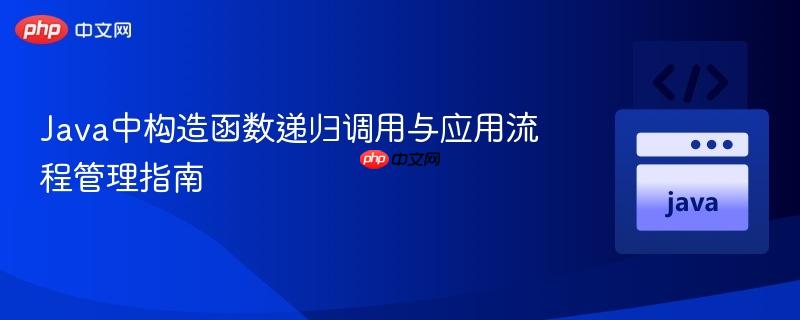
本文深入探讨了java中因构造函数不当设计导致的循环调用问题,特别是在父类构造函数中包含用户交互逻辑时,子类通过`super()`调用会引发递归。文章强调了构造函数应专注于对象初始化,而非业务流程或用户输入,并提供了将用户交互逻辑重构至主方法或工厂方法的解决方案,以优化程序结构和可维护性。
在Java面向对象编程中,构造函数是用于创建和初始化对象的特殊方法。然而,不恰当的设计,尤其是在构造函数中引入复杂的业务逻辑或用户交互,可能导致意想不到的递归调用,从而引发程序陷入“无限循环”的假象。本教程将通过一个具体的案例,详细分析这类问题的原因、危害及解决方案。
考虑以下Java代码结构,其中Person是父类,Agent和Customer是其子类。Person的构造函数中包含了用户选择角色(Agent或Customer)的逻辑:
import java.io.FileWriter;
import java.io.IOException;
import java.io.PrintWriter;
import java.util.ArrayList;
import java.util.List;
import java.util.Scanner;
class Person {
protected String agentId;
protected String password;
protected String address;
public Person(String agentId, String password, String address) {
this.agentId = agentId;
this.password = password;
this.address = address;
// 核心问题:构造函数中包含用户交互和对象创建逻辑
Scanner input = new Scanner(System.in);
System.out.println("[1]AGENT");
System.out.println("[2]CUSTOMER");
int choice = input.nextInt(); // 第一次用户输入
if (choice == 1) {
// 如果选择1,这里会尝试创建一个新的Agent对象
Agent agent = new Agent("Niel", "diko alam", "umay");
// 注意:此处创建新Agent对象时,会再次调用Agent的构造函数
// Agent的构造函数又会通过super()调用Person的构造函数,导致递归
} else if (choice == 2) {
System.out.println("POTANGINA"); // 假设这是Customer的入口
}
// input.close(); // 实际项目中Scanner应妥善关闭,此处为简化示例
}
}
class Agent extends Person {
public Agent(String agentId, String password, String address) {
super(agentId, password, address); // 调用父类Person的构造函数
// ... 后续Agent特有的逻辑 ...
// 这里的super()调用会再次触发Person构造函数中的用户交互
}
// ... 其他Agent方法 ...
}
public class Finals {
public static void main(String[] args) {
// 主方法中创建Person和Agent对象
Person person = new Person("20860132", "h208f32", "San luis");
Agent agent = new Agent("20860132", "h208f32", "San luis"); // 第二次创建Agent对象
}
}当运行上述Finals类中的main方法时,会观察到程序似乎陷入了一个无限循环,不断提示用户选择“[1]AGENT”或“[2]CUSTOMER”。即使输入“1”或“2”,也无法正常进入预期的子类逻辑。
这个问题的根源在于Java构造函数的调用机制和不当的设计:
立即学习“Java免费学习笔记(深入)”;
简而言之,父类构造函数中不应该包含会创建子类实例或进行复杂业务流程的逻辑,因为它会在每次子类实例化时被重复执行。
解决此问题的关键在于遵循“单一职责原则”,将对象初始化和用户交互/业务流程逻辑分离。构造函数应仅负责初始化对象的成员变量,而用户交互和对象创建的决策应放在构造函数之外。
将Person和Agent构造函数中的用户交互和对象创建逻辑移除,使它们专注于初始化各自的成员变量。
Person类(简化版):
class Person {
protected String agentId;
protected String password;
protected String address;
public Person(String agentId, String password, String address) {
this.agentId = agentId;
this.password = password;
this.address = address;
// 构造函数中不再包含用户交互和子类对象创建
}
}Agent类(简化版):
class Agent extends Person {
public Agent(String agentId, String password, String address) {
super(agentId, password, address); // 仅调用父类构造函数进行初始化
// ... Agent特有的初始化逻辑(如果有)...
}
// ... 其他Agent方法 ...
}Customer类(简化版,以供参考):
class Customer extends Person {
private String customerId;
public Customer(String agentId, String password, String address, String customerId) {
super(agentId, password, address);
this.customerId = customerId;
}
public void setCustomerId(String customerId) {
this.customerId = customerId;
}
public String getCustomerId() {
return customerId;
}
// ... 其他Customer方法 ...
}现在,用户选择角色的逻辑应该在程序的主入口点(如main方法)或者一个专门的工厂方法中处理,根据用户的选择来创建相应的对象。
Finals类(重构版):
import java.util.Scanner;
public class Finals {
// 辅助方法,用于显示菜单并获取用户选择
public static int getUserChoice(Scanner scanner) {
System.out.println("[1]AGENT");
System.out.println("[2]CUSTOMER");
System.out.print("请选择您的角色: ");
while (!scanner.hasNextInt()) {
System.out.println("无效输入,请输入数字1或2。");
scanner.next(); // 消费掉无效输入
System.out.print("请选择您的角色: ");
}
int choice = scanner.nextInt();
// 消费掉换行符,以防后续nextLine()读取到空行
scanner.nextLine();
return choice;
}
public static void main(String[] args) {
Scanner mainScanner = new Scanner(System.in);
Person user = null; // 声明一个Person类型的引用
System.out.println("欢迎来到系统!");
int initialChoice = getUserChoice(mainScanner);
switch (initialChoice) {
case 1:
System.out.println("您选择了AGENT。");
// 在这里创建Agent对象
user = new Agent("20860132", "h208f32", "San luis");
// 接下来可以调用Agent特有的登录和操作逻辑
// 例如:((Agent)user).loginAndPerformActions(mainScanner);
break;
case 2:
System.out.println("您选择了CUSTOMER。");
// 在这里创建Customer对象
user = new Customer("默认ID", "默认密码", "默认地址", "CUST001");
// 例如:((Customer)user).viewCarsAndRent(mainScanner);
break;
default:
System.out.println("无效的选择,程序退出。");
break;
}
if (user != null) {
System.out.println("对象创建成功,类型为: " + user.getClass().getSimpleName());
// 可以在这里继续进行后续操作,例如调用user对象的方法
}
mainScanner.close(); // 关闭Scanner
}
}为了展示Agent类如何被使用,我们可以添加一个方法来处理其特有的登录和菜单逻辑。
Agent类(完善版):
class Agent extends Person {
public Agent(String agentId, String password, String address) {
super(agentId, password, address);
}
// 新增方法:处理Agent的登录和后续操作
public void loginAndPerformActions(Scanner input) {
System.out.println("[LOGIN]");
System.out.print("ENTER AGENT ID:");
// 使用next()而不是nextInt(),然后手动解析,以避免nextLine()的问题
String idStr = input.next();
System.out.print("ENTER PASSWORD:");
String passStr = input.next();
// 假设ID和密码是String类型,更符合实际
if (idStr.equals(this.agentId) && passStr.equals(this.password)) {
System.out.println("登录成功!");
boolean logout = false;
while (!logout) {
System.out.println("\n[1]ADD CAR");
System.out.println("[2]SCHEDULE");
System.out.println("[3]RECORDS");
System.out.println("[4]LOGOUT");
System.out.print("请选择操作: ");
while (!input.hasNextInt()) {
System.out.println("无效输入,请输入数字。");
input.next();
System.out.print("请选择操作: ");
}
int choice2 = input.nextInt();
input.nextLine(); // 消费掉换行符
switch (choice2) {
case 1:
addCarFlow(input);
break;
case 2:
System.out.print("Enter schedule details: ");
schedule(input.nextLine());
System.out.println("日程已添加。");
break;
case 3:
System.out.print("Enter record details: ");
records(input.nextLine());
System.out.println("记录已添加。");
break;
case 4:
logout = true;
System.out.println("已退出代理人系统。");
break;
default:
System.out.println("无效选择,请重试。");
}
}
} else {
System.out.println("ID或密码不正确,请重试。");
}
}
private void addCarFlow(Scanner input) {
boolean addMore = true;
List<String> cars = new ArrayList<>();
// 初始车辆列表可以从文件加载或硬编码
cars.add("Toyota");
cars.add("Hillux");
cars.add("Bugatti");
do {
System.out.println("\n[当前车辆列表]: " + cars);
System.out.print("请输入要添加的车辆: ");
String car = input.nextLine();
cars.add(car);
addCar(cars); // 将当前列表写入文件
System.out.println("是否继续添加更多车辆?");
System.out.println("[1]是");
System.out.println("[2]否");
System.out.print("请选择: ");
while (!input.hasNextInt()) {
System.out.println("无效输入,请输入数字1或2。");
input.next();
System.out.print("请选择: ");
}
int choice3 = input.nextInt();
input.nextLine(); // 消费掉换行符
if (choice3 != 1) {
addMore = false;
}
} while (addMore);
System.out.println("车辆添加流程结束。");
}
public void addCar(List<String> cars) {
try (FileWriter fw = new FileWriter("cars.txt", true);
PrintWriter pw = new PrintWriter(fw)) {
pw.println(cars);
} catch (IOException e) {
e.printStackTrace();
}
}
public void schedule(String schedule) {
try (FileWriter fw = new FileWriter("schedule.txt", true);
PrintWriter pw = new PrintWriter(fw)) {
pw.println(schedule);
} catch (IOException e) {
e.printStackTrace();
}
}
public void records(String record) {
try (FileWriter fw = new FileWriter("records.txt", true);
PrintWriter pw = new PrintWriter(fw)) {
pw.println(record);
} catch (IOException e) {
e.printStackTrace();
}
}
}Finals类(最终调用):
import java.util.Scanner;
public class Finals {
public static int getUserChoice(Scanner scanner) {
System.out.println("[1]AGENT");
System.out.println("[2]CUSTOMER");
System.out.print("请选择您的角色: ");
while (!scanner.hasNextInt()) {
System.out.println("无效输入,请输入数字1或2。");
scanner.next();
System.out.print("请选择您的角色: ");
}
int choice = scanner.nextInt();
scanner.nextLine();
return choice;
}
public static void main(String[] args) {
Scanner mainScanner = new Scanner(System.in);
Person user = null;
System.out.println("欢迎来到系统!");
int initialChoice = getUserChoice(mainScanner);
switch (initialChoice) {
case 1:
System.out.println("您选择了AGENT。");
Agent agent = new Agent("20860132", "20020729", "San luis"); // 使用实际的Agent ID和密码
agent.loginAndPerformActions(mainScanner); // 调用Agent的业务逻辑方法
user = agent;
break;
case 2:
System.out.println("您选择了CUSTOMER。");
Customer customer = new Customer("默认ID", "默认密码", "默认地址", "CUST001");
// customer.viewCarsAndRent(mainScanner); // 假设Customer也有类似的方法
user = customer;
break;
default:
System.out.println("无效的选择,程序退出。");
break;
}
if (user != null) {
System.out.println("程序结束,当前用户类型为: " + user.getClass().getSimpleName());
}
mainScanner.close();
}
}本教程通过分析一个常见的Java编程陷阱——构造函数中的递归调用,强调了将对象初始化与业务逻辑分离的重要性。通过将用户交互和对象创建决策从构造函数中移除,并将其放置在主方法或专门的业务逻辑方法中,我们不仅解决了循环问题,还提升了代码的结构清晰度、可读性和可维护性。遵循单一职责原则是编写健壮、可扩展Java应用程序的关键。
以上就是Java中构造函数递归调用与应用流程管理指南的详细内容,更多请关注php中文网其它相关文章!

每个人都需要一台速度更快、更稳定的 PC。随着时间的推移,垃圾文件、旧注册表数据和不必要的后台进程会占用资源并降低性能。幸运的是,许多工具可以让 Windows 保持平稳运行。

Copyright 2014-2025 https://www.php.cn/ All Rights Reserved | php.cn | 湘ICP备2023035733号